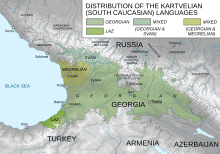Laz language
| Laz | |
|---|---|
| Lazuri, ლაზური | |
| Native to | Turkey, Georgia |
| Ethnicity | Laz people |
|
Native speakers
|
22,000 (2007) |
|
Latin script Georgian script |
|
| Language codes | |
| ISO 639-3 | |
| Glottolog | lazz1240 |
 |
|
The Laz language (ლაზური ნენა, lazuri nena; Georgian: ლაზური ენა, lazuri ena, or ჭანური ენა, ç̌anuri ena, also chanuri ena) is a Kartvelian language spoken by the Laz people on the southeastern shore of the Black Sea. It is estimated that there are around 20,000 native speakers of Laz in Turkey, in a strip of land extending from Melyat to the Georgian border (officially called Lazistan until 1925), and about 2,000 in Georgia.
Laz is one of the four South Caucasian languages. Along with Mingrelian, it forms the Zan branch of this Kartvelian language family. The two languages are very closely related, to the extent that some linguists refer to Mingrelian and Laz as dialects or regional variants of a single Zan language, a view held officially in the Soviet era and still so in Georgia today. In general, however, Mingrelian and Laz are considered as separate languages, due both to the long-standing separation of their communities of speakers (500 years) and to a lack of mutual intelligibility. The Laz are shifting to the Turkish of Trebizond.
The Georgian language, along with its relatives Mingrelian, Laz, and Svan, comprises the Kartvelian (South Caucasian) language family. The initial breakup of Proto-Kartvelian is estimated to have been around 2500–2000 B.C., with the divergence of Svan from Proto-Kartvelian (Nichols, 1998). Assyrian, Urartian, Greek, and Roman documents reveal that in early historical times (2nd–1st millennia B.C.), the numerous Kartvelian tribes were in the process of migrating into the Caucasus from the southwest. The northern coast and coastal mountains of Asia Minor were dominated by Kartvelian peoples at least as far west as Samsun. Their eastward migration may have been set in motion by the fall of Troy (dated by Eratosthenes to 1183 B.C.). It thus appears that the Kartvelians represent an intrusion into the Georgian plain from northeastern Anatolia, displacing their predecessors, the unrelated Northwest Caucasian and Vainakh peoples, into the Caucasian highlands (Tuite, 1996; Nichols, 2004).
...
Wikipedia
